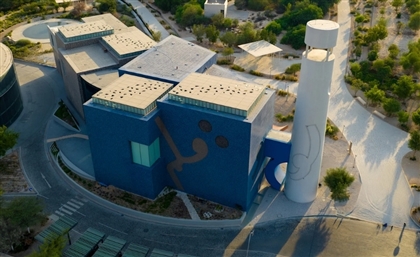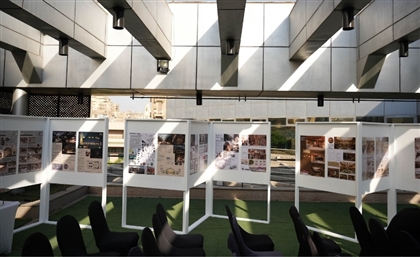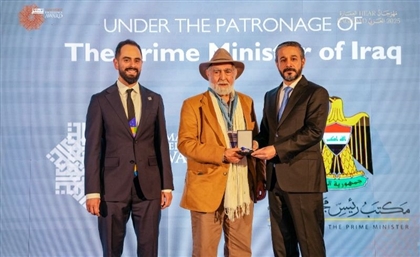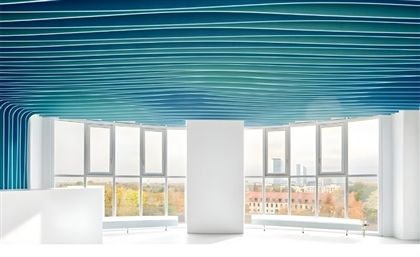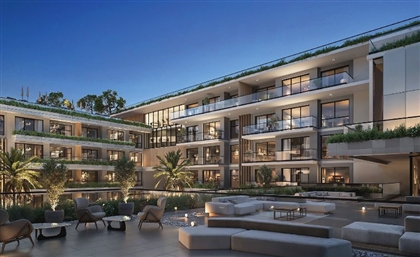Uncovering Egyptian Inspiration in America’s Art Deco Architecture
Here is how the discovery of King Tut’s tomb inspired some of America’s most iconic buildings.

In November 2025, the opening of the Grand Egyptian Museum brought renewed attention to Egypt’s long-standing cultural influence. Ancient Egypt has shaped global fashion, art, architecture, and cultural imagination for centuries, with the discovery of King Tutankhamun’s tomb—one of the most intact royal burials—becoming a defining moment in the modern understanding of the era. The global fascination that followed, often referred to as “Egyptomania,” helped inspire the development of Art Deco architecture across the globe, particularly in the United States.
Art Deco adopted many elements drawn from ancient Egyptian design, including angular forms, symmetry, stylised lotus motifs, zigzag and chevron patterns, symbolic use of flora and fauna, vivid colour palettes, and the recurring presence of solar disc imagery. These aesthetic traits became central to the movement and are still recognisable in buildings worldwide.
Gold, heavily associated with Egyptian royal burial practices, also found its way into early- to mid-twentieth-century Art Deco architecture, appearing in decorative surfaces and interiors. Its use contributed to the bold, ornamental character that defined many landmark structures of the period.
Here are some of the most iconic Art Deco structures in the United States - and how the legacy of ancient Egypt shines through each of its gilded details.
Chrysler Building — New York, New York
-4f0346ed-10af-4e76-aadb-bb4e3e2c4923.jpg) Designed by William Van Alen, the Chrysler Building remains one of the most prominent skyscrapers in the Manhattan skyline. Causing a break in the pattern of steel minimalist architecture that plagued New York in the late 20s, Van Alen mixed industrialism with the striking nature of Art Deco. The terracotta and brick facade pleasantly contrasts with its radiant steel crown, which reimagines the sun god Ra’s sundisk through bursting triangular windows. Its repetitive geometry and ornamental patterns echo forms of sunbursts and lotuses blooming through the sky, reinterpreting the presence of royalty through contemporary industrial materials.
Griffith Observatory — Los Angeles, California
Designed by William Van Alen, the Chrysler Building remains one of the most prominent skyscrapers in the Manhattan skyline. Causing a break in the pattern of steel minimalist architecture that plagued New York in the late 20s, Van Alen mixed industrialism with the striking nature of Art Deco. The terracotta and brick facade pleasantly contrasts with its radiant steel crown, which reimagines the sun god Ra’s sundisk through bursting triangular windows. Its repetitive geometry and ornamental patterns echo forms of sunbursts and lotuses blooming through the sky, reinterpreting the presence of royalty through contemporary industrial materials.
Griffith Observatory — Los Angeles, California
-29955ad9-acbc-49a3-bb96-50dd1c966fe4.jpg) Completed in 1935, the Griffith Observatory is one of the most visited landmarks in southern California. Its simple concrete facade featuring the Greek Key combines a number of architectural styles including Art Deco, Greco-Roman, and Beaux-Art. Architects John C. Austin and Frederick M. Ashley emphasised sleek symmetry in its design, parallel to ancient temple architecture, and bridging Egypt’s connection to astronomy and mysticism with modern science. Unique copper components, including the notable domes, distinct geometric forms, and clean lines represent the simple but ostentatious nature of the building, mimicking subtle yet notable ancient ornamentation. Chevron wall patterns and hieroglyphic motifs reinterpret the decorative geometry carved into ancient landmarks, as embellished iron window grilles, and the use of elaborate materials such as marble and bronze mark the structure as one of the most iconic in North America.
Carbide & Carbon Building — Chicago, Illinois
Completed in 1935, the Griffith Observatory is one of the most visited landmarks in southern California. Its simple concrete facade featuring the Greek Key combines a number of architectural styles including Art Deco, Greco-Roman, and Beaux-Art. Architects John C. Austin and Frederick M. Ashley emphasised sleek symmetry in its design, parallel to ancient temple architecture, and bridging Egypt’s connection to astronomy and mysticism with modern science. Unique copper components, including the notable domes, distinct geometric forms, and clean lines represent the simple but ostentatious nature of the building, mimicking subtle yet notable ancient ornamentation. Chevron wall patterns and hieroglyphic motifs reinterpret the decorative geometry carved into ancient landmarks, as embellished iron window grilles, and the use of elaborate materials such as marble and bronze mark the structure as one of the most iconic in North America.
Carbide & Carbon Building — Chicago, Illinois
-186072d6-be82-4a4f-8966-f49b266d311c.jpg) One of the most extraordinary buildings in the Chicago skyline, the Carbide and Carbon Building was designed by the Burnham Brothers and completed in 1929. Its unique green terracotta facade complemented by its reflective black granite base sets the canvas for its acclaimed genuine 24 karat gold embellishments located at the top of the building, which recalls the gilded treasures of King Tut’s tomb. The interior, adorned with Belgian black marble, gold detailing and staple Egyptian motifs, including the lotus, exhibit the height of Egyptomania in the twenties.
Paramount Theatre — Oakland, California
One of the most extraordinary buildings in the Chicago skyline, the Carbide and Carbon Building was designed by the Burnham Brothers and completed in 1929. Its unique green terracotta facade complemented by its reflective black granite base sets the canvas for its acclaimed genuine 24 karat gold embellishments located at the top of the building, which recalls the gilded treasures of King Tut’s tomb. The interior, adorned with Belgian black marble, gold detailing and staple Egyptian motifs, including the lotus, exhibit the height of Egyptomania in the twenties.
Paramount Theatre — Oakland, California
-b9d29de4-2a04-4991-a807-bc34236b3bff.jpg) This 3,040 seat concert hall designed by Timothy Pflueger built in 1931 epitomises Art Deco design. The formidable style of the exterior stands as one of the most notable and identifiable examples of Art Deco in contemporary America. Its mosaic mural facade, with its rich colour and storytelling features, can easily be related to the artistic nature of hieroglyphs. Coated in gold embellishments and featuring patterns that take you back in time to Ancient Egypt, the interior lives up to the expectations set by the ezterior. The attention to every minute detail speaks to the unique craftsmanship of Pflueger, making it one of the finest examples of Art Deco in the world.
Cincinnati Union Terminal — Cincinnati, Ohio
This 3,040 seat concert hall designed by Timothy Pflueger built in 1931 epitomises Art Deco design. The formidable style of the exterior stands as one of the most notable and identifiable examples of Art Deco in contemporary America. Its mosaic mural facade, with its rich colour and storytelling features, can easily be related to the artistic nature of hieroglyphs. Coated in gold embellishments and featuring patterns that take you back in time to Ancient Egypt, the interior lives up to the expectations set by the ezterior. The attention to every minute detail speaks to the unique craftsmanship of Pflueger, making it one of the finest examples of Art Deco in the world.
Cincinnati Union Terminal — Cincinnati, Ohio
-2aeb04f0-7591-49ad-97e8-33d29effa4f6.jpg) Planned by American architect Alfred T. Fellheimer, and reformed by French-born architect Paul Phillipe Cret, the Cincinnati Union Terminal fuses an exterior Moderne design with a unique Art Deco interior. This terminal was not designed to be lavish, but to be imposing, drawing on the sense of permanence and power that ancient Egyptians were so fond of. The trademark massive semicircular arch complemented by nine large vertical windows and an enormous clock represents a sleek take on Art Deco elements including bold geometry and classic ornamentation. In its huge arches, bold use of colour, and glass mosaic murals, the building comes into its own as a celebration of art, technology and legacy that define the era.
Eastern Columbia Building — Los Angeles, California
Planned by American architect Alfred T. Fellheimer, and reformed by French-born architect Paul Phillipe Cret, the Cincinnati Union Terminal fuses an exterior Moderne design with a unique Art Deco interior. This terminal was not designed to be lavish, but to be imposing, drawing on the sense of permanence and power that ancient Egyptians were so fond of. The trademark massive semicircular arch complemented by nine large vertical windows and an enormous clock represents a sleek take on Art Deco elements including bold geometry and classic ornamentation. In its huge arches, bold use of colour, and glass mosaic murals, the building comes into its own as a celebration of art, technology and legacy that define the era.
Eastern Columbia Building — Los Angeles, California
-ffdacce8-92ea-47f6-902e-0b4b19e546ad.jpg) The Eastern Columbia Building designed by Claud Beelman features vibrant turquoise terracotta facade paired with a lapis blue and gold trim, which are strongly suggestive of ancient Egypt’s most used colours. Its Art Deco trademarks including geometric shapes, chevron patterns, unique plant and animal motifs, and its eye-catching gold sun art work stand as unique examples of boundary breaking architecture. Most notably, the dramatic four-sided clock tower represents the elegant and inventive nature of twentieth century design.
Warner Theatre — Erie, Pennsylvania
The Eastern Columbia Building designed by Claud Beelman features vibrant turquoise terracotta facade paired with a lapis blue and gold trim, which are strongly suggestive of ancient Egypt’s most used colours. Its Art Deco trademarks including geometric shapes, chevron patterns, unique plant and animal motifs, and its eye-catching gold sun art work stand as unique examples of boundary breaking architecture. Most notably, the dramatic four-sided clock tower represents the elegant and inventive nature of twentieth century design.
Warner Theatre — Erie, Pennsylvania
-dacca51e-5fd8-4d78-b775-4d922e71c0f2.jpg) With an interior that acts as a kindred to the Paramount Theatre, the Warner combines Art Deco and French Renaissance style for a truly unique yet classic feel. Designed by the Rapp & Rapp Company based out of Chicago, the facade is simple but effective at drawing attention. Its geometric tiling complemented by gold gilding and showboating neon lights pull your eyes in every direction. Use of luxurious materials, such as solid bronze for the ticketing booths, speak to the magnificence ancient Egypt. The enchanting exterior is contrasted with the elaborate interior, where gold coating spotlights a grand staircase, and bronze banisters lead through an archway of marble, gold accents, and antique drapery. Its features treat the theatre as a modern temple of entertainment, where artistry and the divine intersect.
Marlin Hotel — Miami Beach, Florida
With an interior that acts as a kindred to the Paramount Theatre, the Warner combines Art Deco and French Renaissance style for a truly unique yet classic feel. Designed by the Rapp & Rapp Company based out of Chicago, the facade is simple but effective at drawing attention. Its geometric tiling complemented by gold gilding and showboating neon lights pull your eyes in every direction. Use of luxurious materials, such as solid bronze for the ticketing booths, speak to the magnificence ancient Egypt. The enchanting exterior is contrasted with the elaborate interior, where gold coating spotlights a grand staircase, and bronze banisters lead through an archway of marble, gold accents, and antique drapery. Its features treat the theatre as a modern temple of entertainment, where artistry and the divine intersect.
Marlin Hotel — Miami Beach, Florida
-b572bd76-8f95-4b25-bae8-69c542a272b4.jpg) While much smaller, standing at three stories, the Marlin Hotel designed by L. Murray Dixon remains an impactful member of the Art Deco herd. Its unique pastel blue and yellow facade with its iconic “eyebrows” located above each window, makes this building a stand-out on this list. Its casual ambience pleasantly contrasts the traditionally extravagant interpretations of its style, offering a stylised take on Art Deco. While the rooms have undergone contemporary renovation, the vintage terrazzo flooring featuring geometric patterns and pastel tones similar to the exterior secure the building's connection to its roots. Observable above the front entrance to the top of the facade are colourful patterned panels, enhancing the pastel themes and guiding the gaze upward. These ornamental panels and sunlit pastel hues can be read as a modern interpretation of ancient decorative symbolism reimagined through Miami’s coastal, modern energy.
While much smaller, standing at three stories, the Marlin Hotel designed by L. Murray Dixon remains an impactful member of the Art Deco herd. Its unique pastel blue and yellow facade with its iconic “eyebrows” located above each window, makes this building a stand-out on this list. Its casual ambience pleasantly contrasts the traditionally extravagant interpretations of its style, offering a stylised take on Art Deco. While the rooms have undergone contemporary renovation, the vintage terrazzo flooring featuring geometric patterns and pastel tones similar to the exterior secure the building's connection to its roots. Observable above the front entrance to the top of the facade are colourful patterned panels, enhancing the pastel themes and guiding the gaze upward. These ornamental panels and sunlit pastel hues can be read as a modern interpretation of ancient decorative symbolism reimagined through Miami’s coastal, modern energy.
- Previous Article MillerKnoll Launches in Egypt with Style Design
- Next Article C. Reality Unveils ‘Threads of Egypt’ at Cairo Design Week




